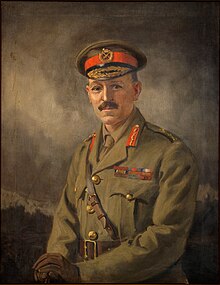Sir Andrew Hamilton Russell | |
|---|---|
 Portrait painted by George Edmund Butler | |
| Born | 23 February 1868 Napier, New Zealand |
| Died | 29 November 1960 (aged 92) Tunanui, New Zealand |
| Allegiance | United Kingdom New Zealand |
| Service | British Army New Zealand Military Forces |
| Years of service | 1887–1892 1900–1932 1940–1941 |
| Rank | Major General |
| Unit | Border Regiment |
| Commands | New Zealand Division New Zealand and Australian Division New Zealand Mounted Rifles Brigade |
| Battles / wars | First World War Second World War |
| Awards | Knight Commander of the Order of the Bath Knight Commander of the Order of St Michael and St George Mentioned in despatches (9) |
| Other work | Returned Services' Association |
Major General Sir Andrew Hamilton Russell KCB, KCMG (23 February 1868 – 29 November 1960) was a senior officer of the New Zealand Military Forces who served during the First World War.
Born in Napier, New Zealand, Russell spent most of his youth in England. He joined the British Army in 1888 and served in India before transferring to the Indian Army in pursuit of a more active life. He grew disillusioned with his career and resigned his commission in 1892 to become a farmer in New Zealand. Running a sheep farm on land owned by his father, he retained an interest in soldiering and helped raise a local militia unit before becoming a senior officer in the New Zealand Territorial Force.
Appointed to command the New Zealand Mounted Rifles Brigade upon the outbreak of war, he rose swiftly to high command during the Gallipoli campaign and in December 1915 became commander of the New Zealand and Australian Division. He oversaw the evacuation of the Australian and New Zealand Army Corps from Gallipoli. He commanded the New Zealand Division, formed in March 1916, throughout its service on the Western Front, leading it during major engagements during the Battles of the Somme, Messines and Passchendaele, the German spring offensive and the Hundred Days Offensive. After the war, he returned to farming life. He soon became heavily involved in veteran's affairs, lobbied in favour of defensive spending, and participated in local body politics. In the early years of the Second World War, he served as the Inspector General of New Zealand Military Forces. He died in 1960 at the age of 92 and is commemorated in Hastings Civic Square with a bronze statue standing over Russell Street next to the Hastings Cenotaph.